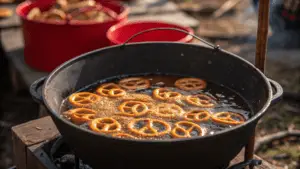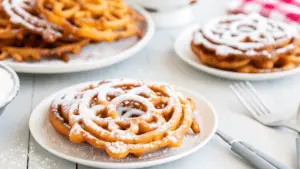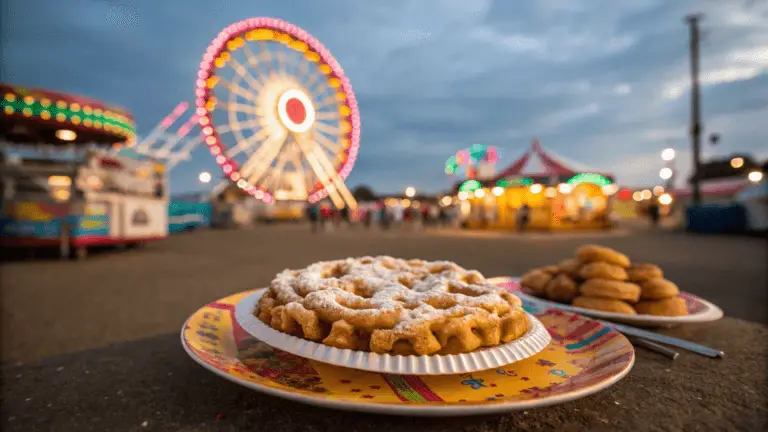The phrase “funnel cake” might conjure up memories of bustling carnivals, powdered sugar, and the aroma of fried batter wafting through the air. But have you ever stopped to wonder why it’s called funnel cake? This article peels back the layers of history, culture, and etymology behind this beloved treat. From its humble beginnings in Europe to its star-studded role in American fairs, we’ll explore its origins, the intriguing use of a funnel in its preparation, and how it became a festival staple. Let’s dive in, starting with where it all began.
The Origins of Funnel Cake
Tracing the Recipe Back in Time
The origins of funnel cake go back centuries, long before it graced the countertops of modern food trucks. Ancient civilizations had their versions of fried dough, with recipes found in medieval European cookbooks. These early versions included dough made from simple ingredients like flour, water, and eggs, fried to golden perfection.
In regions like the Middle East, fried dough treats like zalabiya share similarities with funnel cake, underscoring a universal love for crispy, sweet delights. This cross-cultural thread highlights how the concept of fried dough traveled and evolved with each passing century.
Introduction to Funnel Cake in America
Fast forward to the 17th and 18th centuries, and we find German immigrants—better known as the Pennsylvania Dutch introducing their own variation of fried dough to America. Known as drechter kuche (which translates to “twisted cake”), this treat bore a striking resemblance to what we now call funnel cake. The name evolved over time, but the essence of the dish remained: a simple yet delightful fried dessert.
With its crispy edges, light texture, and sprinkling of sugar, funnel cake quickly became a beloved dish among communities. As fairs and festivals became part of American culture, this treat found a natural home, delighting crowds and symbolizing joy.
The Etymology of Funnel Cake

Why ‘Funnel’?
Ever wondered why they call it funnel cake? The answer lies in its preparation. The batter, made from a mix of simple ingredients like flour, eggs, and milk, is poured through a funnel into hot oil. As the batter flows, it forms a delicate, lacy web of dough that fries to crispy perfection. The funnel isn’t just a handy kitchen tool here it’s the star of the show.
Historically, using a funnel ensured the batter could be shaped into intricate patterns without special equipment. This simple technique became a hallmark of the dish, giving it not only its distinctive appearance but also its unique name. Without the funnel, this dessert might have ended up with a much less intriguing title!
Why ‘Cake’?
But why call it a “cake”? After all, it’s fried, not baked, and its texture is crisp rather than soft. During earlier centuries, the term “cake” was often used more loosely to describe a variety of sweet, dough-based treats, regardless of how they were cooked. In this context, funnel cake refers to a sweet, indulgent creation made from batter, fitting neatly into the broader historical use of the term.
Together, the words “funnel” and “cake” perfectly capture the essence of this beloved treat. Its name is a nod to both the method of preparation and its rich heritage. So, the next time you savor this carnival favorite, you’ll know exactly why they call it funnel cake.
Cultural Significance of Funnel Cake
A Staple of Fairs and Festivals
It’s hard to imagine a carnival or county fair without the irresistible scent of funnel cake wafting through the air. This treat isn’t just a food—it’s an experience. Its presence at fairs and festivals symbolizes celebration, indulgence, and nostalgia. Families gather around booths to share this sweet treat, marking moments of togetherness and joy.
Historically, funnel cakes became popular at these events because they were simple to make and sell. The batter’s low cost, combined with its high visual appeal, made it a favorite among vendors. Over time, it evolved into a cultural icon synonymous with American festivals.
Regional Variations and Innovations
Although the classic funnel cake recipe remains timeless, regions across the U.S. have put their own spin on it. From toppings like whipped cream, strawberries, and chocolate drizzle to savory versions with cheese or spices, the variations are endless. Each adaptation reflects local tastes and creativity, adding another layer to the story of funnel cake.
Even internationally, variations of funnel cake can be found under different names. From Canada’s “beaver tails” to India’s “jalebi,” the idea of fried dough topped with sweet goodness resonates across cultures.
Through its journey from humble beginnings to carnival fame, funnel cake has become more than just a dessert—it’s a symbol of festivity and innovation. And now you know why they call it funnel cake, a name as unique and delightful as the treat itself.
How Funnel Cake is Made
Ingredients and Equipment
Making funnel cake at home is surprisingly simple, requiring just a few pantry staples. You’ll need flour, sugar, milk, eggs, baking powder, and a pinch of salt. Combine these ingredients to create a smooth batter that’s easy to pour. The most important tool for this dessert? A funnel! It gives the cake its iconic swirls and twists. Don’t have one? No worries—alternatives like squeeze bottles or piping bags work just as well.
You’ll also need a deep fryer or a large pan with enough oil to submerge the batter. For safety, ensure you have tongs or a slotted spoon to carefully flip and remove the cakes once fried.
The Frying Technique
The magic of funnel cake lies in how the batter is poured into hot oil. Start by heating the oil to 375°F (190°C). Pour the batter into the funnel, hold it over the oil, and let it flow in a circular motion, creating overlapping patterns. Fry until golden brown—about 1-2 minutes per side—then flip carefully to cook evenly.
Once it’s done, place the cake on a paper towel to remove excess oil. Finally, dust with powdered sugar or add your favorite toppings like chocolate drizzle or fresh fruit. And voilà! You’ve got a crispy, light, and irresistibly sweet treat that answers the question: Why do they call it funnel cake?
For more dessert inspiration, check out this recipe for chimney cake a similar treat with a fascinating history.

FAQs About Funnel Cake
What Makes Funnel Cake Unique?
Unlike other fried dough recipes, funnel cake stands out for its delicate, lacy structure. The batter’s thin consistency allows it to create overlapping patterns as it’s poured, giving the cake its signature texture. Its crispy edges and soft center are a winning combination that keeps people coming back for more.
Is Funnel Cake the Same Everywhere?
Not quite! While the classic powdered sugar topping remains a staple, regional variations abound. Some areas offer savory funnel cakes topped with cheese or spices, while others pile on sweet extras like whipped cream, caramel, or fruit compote. Internationally, dishes like “jalebi” in India or “beaver tails” in Canada showcase similar concepts with distinct twists.
Can You Make Funnel Cake Without a Funnel?
Yes, absolutely! A piping bag, a squeeze bottle, or even a makeshift funnel made from a cut plastic bag can do the trick. The key is controlling the batter’s flow to create those beautiful swirls. With a bit of practice, you’ll master the technique and understand why they call it funnel cake—no fancy tools needed.
Conclusion
A Timeless Treat
Funnel cake has a way of bridging generations, offering a nostalgic treat that sparks joy at every bite. From bustling fairs to cozy homemade gatherings, its crispy texture and light sweetness remain a universal favorite. But what truly makes it special is its rich history, cultural significance, and the artistry behind its creation. Just like cookie cakes bring their own charm to dessert tables, funnel cake stands as a testament to the creativity of simple ingredients turned into a masterpiece.
Why Funnel Cake Endures
Part of funnel cake’s charm lies in its ability to adapt. Whether topped with traditional powdered sugar or modern embellishments like chocolate syrup and fruit, it continues to evolve with the times. Its festive appearance and crowd-pleasing nature ensure that funnel cake remains a staple in celebrations, big or small.
Ultimately, funnel cake is more than just a dessert. It’s a cultural icon, a cherished memory, and a delightful indulgence. And now you know the answer to the question: Why do they call it funnel cake? It’s a name and a treat that has earned its place in hearts around the world.
FAQs About Similar Desserts
How Are Funnel Cakes Different from Cookie Cakes?
Although funnel cakes and cookie cakes both cater to sweet cravings, they couldn’t be more different in preparation and texture. Funnel cakes are fried and crispy, while cookie cakes are baked and chewy, offering an entirely unique dessert experience. Both, however, share one key trait: they’re guaranteed to bring smiles.
Can Funnel Cakes Be Made at Home Easily?
Absolutely! With basic ingredients and a bit of practice, you can recreate the magic of funnel cake in your kitchen. The same goes for other treats like cookie cakes both are perfect for experimenting with toppings and flavors.
Are There Other Desserts Similar to Funnel Cake?
Yes, and they span the globe! From India’s “jalebi” to Canada’s “beaver tails,” variations of fried dough have become cultural treasures in many regions. Each has its own spin on the concept, much like how cookie cakes have multiple versions to suit different tastes.
Modern Twists on Funnel Cake
Creative Toppings and Flavors
Today, funnel cakes are far from ordinary. Chefs and home cooks alike have found ways to reinvent this classic treat with exciting toppings and flavors. Traditional powdered sugar remains a favorite, but modern variations include everything from drizzled caramel and hot fudge to fresh fruits like strawberries and blueberries. There are even savory versions with toppings like shredded cheese, bacon bits, or a sprinkle of herbs, creating a whole new dimension to this beloved dessert.
The adaptability of funnel cake is one reason it’s remained popular. Whether you enjoy it with a scoop of ice cream or a drizzle of maple syrup, there’s a version for every craving. If you’ve ever wondered, Why do they call it funnel cake? its versatility in both preparation and presentation adds another layer to its story.
Funnel Cake Beyond the Fair
While fairs and carnivals might be the most iconic places to enjoy funnel cake, the treat has also made its way into upscale dining and themed cafes. Some restaurants offer gourmet versions, complete with luxury toppings like gold leaf or exotic fruits. Meanwhile, DIY enthusiasts are bringing it home, using creative tools like waffle irons and air fryers to add their own twist.
Much like its name, funnel cake continues to evolve, ensuring it remains a favorite for generations to come.
The Global Influence of Fried Dough
Similar Desserts Around the World
Funnel cake might feel uniquely American, but its roots and cousins span the globe. In India, jalebi offers a strikingly similar experience, with its spiraled shapes and sugary coating. Canada’s beaver tails are flat and topped with various delights, while Hungary’s kürtőskalács (chimney cake) adds a caramelized crunch.
These desserts all showcase the universal love for fried dough. While their shapes and toppings may differ, the shared concept speaks to how food can transcend cultural boundaries. And yet, each holds its own story just as funnel cake’s history answers the question, Why do they call it funnel cake?
Why Funnel Cake Stands Out
What sets funnel cake apart from its global counterparts is its combination of simplicity and artistry. The intricate swirls formed by the funnel technique give it a playful, almost whimsical look. Its light, airy texture makes it feel indulgent without being overly heavy.
This balance of beauty and taste has cemented funnel cake’s place as a standout dessert. It might share a stage with other fried treats, but it’s undeniably unique in its charm.

